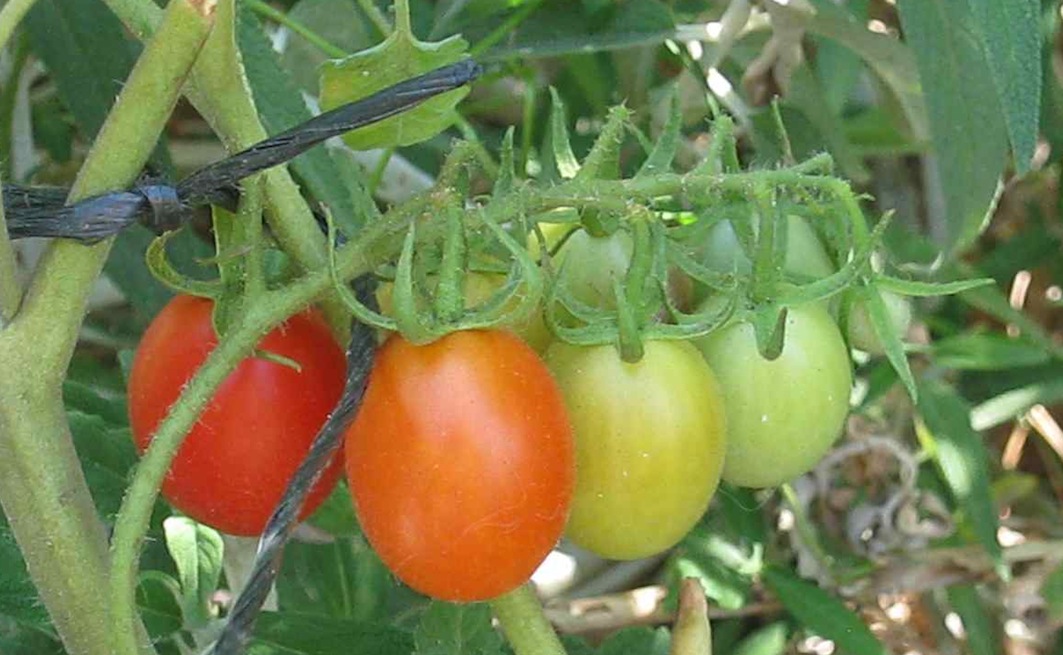Dear Reader, in this age of AI created content, please support with your goodwill someone who works harder to provide the human-made. Sign up in the righthand column or bottom of this page. You will receive my hand illustrated monthly newsletter RESTORE NATURE and access to the biodiversity garden design course as I write...and nothing else, I respect your time.
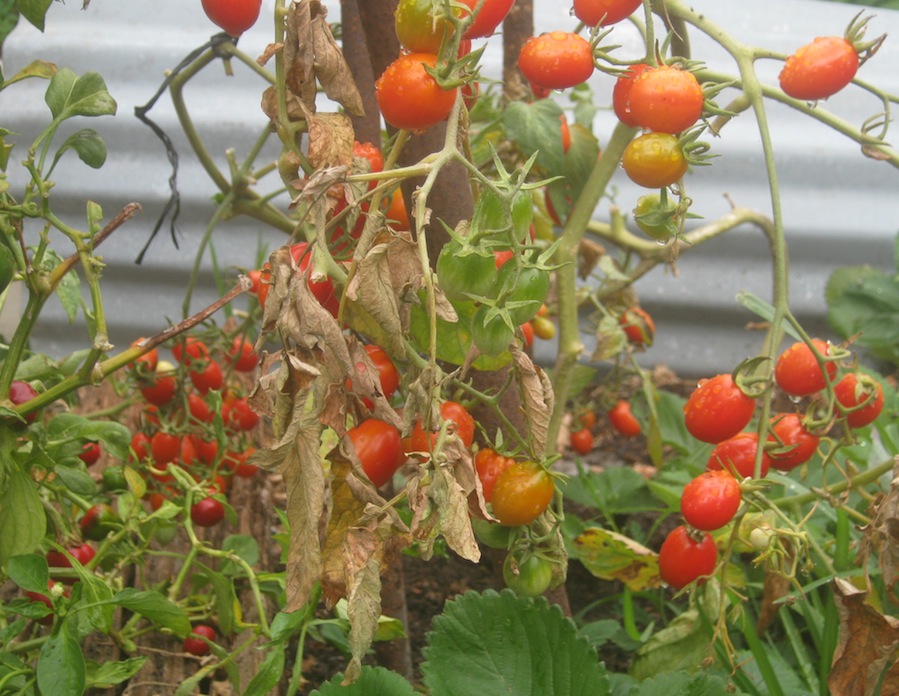
Growing organic tomatoes, smaller varieties are very rewarding.
The history and diversity in growing organic tomatoes
Growing organic tomatoes is a time honoured activity, and just how easy it is will be outlined in the last third of this article. The wild habitat of the tomato is the western seaboard of South America, within the tropical zone. The Aztecs were the first to ‘tame’ the tomato, growing small golden ones, like our modern cocktail tomatoes but the large lumpy tomatoes ancestral to many modern varieties also originated in Mesoamerica.
The tomato challenges the rose by tasting sweet despite a diversity of names. The delights of growing your own include an extended harvest (see instructions for growing organic tomatoes at the bottom of the page). Yet the history is bitter for a fruit so sweet. The name tomatl ‘swelling/fat - liquid/fruit’ in Nahuatl, the Aztec language, was first given to today’s tomatillo, a grass green fruit with a papery pod, a different genus and species. Another different golden fruit ancestor of the tomato was brought to Aztec Mexico, cultivated as food by 500 BC and grown in the floating gardens of Tenochtitlan. It was called xitomatl (navel tomatl ). The Spanish brutally overthrew the city and shortly after xitomatl were exported under the name tomate erasing the names xitomatl and jitomate (early Spanish). They were sent to Spanish territories including the Caribbean and Philippines, from where tomatoes spread to Asia. As new cultures around the world adopted the fruit in different ways, eventually making it integral to global cuisine, it was renamed in different languages, and different nations exploited the fruit commercially.
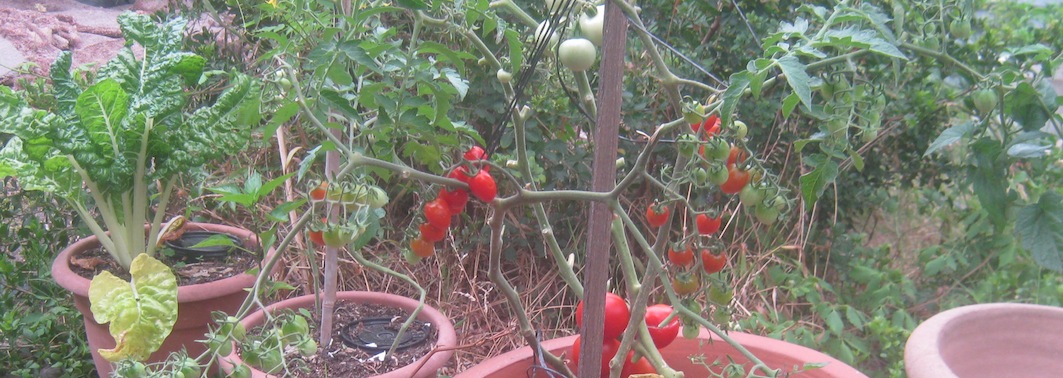
growing organic tomatoes is easy in pots. Replacing soil makes crop rotation superfluous, Nutrients and water easily controlled.
Cultivation began in Spain by 1540 and food use by the 17th Century. The delay was due to their resemblance to the deadly nightshade, an hallucinogen at a dose of about 8 berries and a deadly poison at about 20. In North America the pre Columbian Pueblo people believed that witnessing the consumption of tomato seeds gave divinatory powers. The French, focussing on aphrodisiac properties, called it pomme d’amour (love apple), an Italian herbalist Pietro Andrea Mattioli named them pomodoro (golden apple) around the 1550’s, underlining their exclusively decorative appeal to Italians, till they entered Italian cuisine 150 years later in recipes of Spanish origin. Italian tomatoes today serve the need for making thick sauces and are generally high in solid content and rich in flavour. The Italian name spread to Russian and Polish. In German dialects it was called the Paradeisapfel (paradise apple) hence paradeiser used today in Bavaria and Austria, with versions in Hungary, Slovenia and Serbia. It was introduced in the middle east by a British Consul on the Syrian Turkish border where it became an indispensable ingredient in regional cuisine by the early 1900’s. In Iran the first name was Armani badenjan (Armenian eggplant), its modern name gojeh farangi (foreign plum). Linneaus named it Solanum lycopersicum in 1753, using two names for the deadly nightshade Solanum, and lycopersicum (wolf apple) because ancient Germans believed nightshade consumption turned witches into werewolves. Another botanist called it Lycopersicon esculentum, (edible nightshade). This name is common in horticulture, where it became very popular due to is malleable phenotype, leading to many varieties.
A practice of growing tomatoes only as decorative plants and a prejudice that they were poisonous persisted even until the 1800’s in England and the US. Despite this bad reputation they were grown in Carolina plantations by the 1750’s but had been known to Pueblo people long before that. Waves of immigrants in the mid nineteenth century pushed the development of tomato farming in the US. The breeder Alexander Livingston produced many new varieties, which are now only available as Heirlooms, though ancestral to many commercial cultivars. All the same tomato.
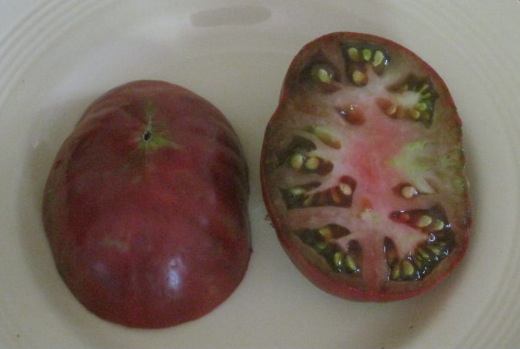
One thrill in growing organic tomatoes is trying non-commercial varieties like the Black Seaman shown here.
general plant description of the tomato
In lay terms a berry is a small fruit. In botanical terms, a tomato is a berry, and so are grapes, eggplants and bananas, while excluding strawberries and black currents. Berries do not have a stone, and the fleshy part develops from the outer layer or pericarp of a single ovary, this excludes apples and pears (pomes) as their fleshy part develops from the flower receptacle not the ovary, stone fruits (drupes), aggregate fruits such as raspberries and multiple fruits like pineapples. It is dicotyledonous.
The tomato berry develops after fertilization, but most are self fertilizing. This means you can be growing organic tomatoes in the city without pollinators. Tomato berries can be red, pink, yellow, orange, green, purple, brown or black. The colours are of special interest to collectors and those growing organic tomatoes from heirloom seed. Depending on variety they have two to five or more fleshy chambers called locular cavities filled with seeds and slippery juice, The tomato’s flesh has much lower sugar concentrations than many other edible fruit. We only eat the fruit as the rest of the plant contains high concentrations of potentially poisonous alkaloids.
The tomato plant is a one to three meter (three to ten foot) branching vine. For those interested in growing organic tomatoes in a backyard garden, cherry tomatoes are usually the easiest, but most are easy to grow and produce large crops given the right attention. They are however susceptible to disease which can be combatted relatively easily.
The tomato is perennial in its native habitat and can live up to three years in a greenhouse, but is annual in cooler zones. The vines naturally lie on the ground if not staked. The plant is covered in short hairs, which can turn into roots when in contact with the ground or moisture. Small bush plants have been bred, and these are annuals in all climates.
They usually have compound leaves, odd pinnate with nine leaflets, and serrated margins, but some cultivars have simple potatoe-leaf styles. They can have rugose or deeply grooved leaves and even angora or variegated leaves.
The one to two centimetre (0.4-0.8 inch) flowers appear on the apical or tip bud meristem. They have fused anthers forming a column around the pistil which promotes self fertilization. The flowers, borne in a cyme of three to twelve blooms that give rise to bunches of tomatoes on small varieties, are yellow with five pointed lobes on the corolla.
unlike most of us the tomato have interesting relatives
Tomatoes are mostly bred varieties of one species of plant. Due to the usual naming wars in botany, there are two alternatives Solanum lycopersicum and Lyciopersicon esculentum. The first name given by Linneaus puts it in the same genus as the potato Solanum tuberosum, although its foliage and chemical properties are different to the rest of the genus. Nonetheless it is possible to make a hybrid of a potato and a tomato in the laboratory, proving their genetic closeness.
Both tomatoes and potatoes belong in a bigger group, the Solanaceae, also known as the nightshade family in Europe. In the Americas there are many more cultivated species in the Solanaceae family that we don’t see too often in South Africa. These include many varieties of peppers, mild and hot, potatoes of all colours and sizes, tomatillos, tamarillos or tree tomatoes, pepino melons, and other edibles.
Some of the family are native to other areas of the world. Tobacco and nicotiana flowers have a wide distribution globally, and may not have originated in the Americas, but spread in the late stone age. Mandrake, the herbal medicine, and eggplants or brinjals the foodstuff are native to and widely distributed across Asia. The belladonna or nightshade, a deadly poisonous hallucinogenic is found in Europe and its mythologies. Cape gooseberries and belladonna are naturalized ‘weeds’ in South Africa.
gardeners growing organic tomatoes pay heed
The implication of all this family closeness for the gardener growing organic tomatoes, is that many members of the group may act as hosts to the same pathogens or pests. This makes regular crop rotation to non Solanaceous plants necessary, and the removal of closely related plants which grow wild or are naturalized, from the area near the vegetable garden, and last but not least, that we must not touch tomato or potato plants after smoking.
The alkaloids in the nightshade family are poisons that are generally tolerated by most humans, but toxic reactions differ between people. This is also why we don’t eat the leaves of most of these plants.
the tomato's wild relatives
A sub group of the genus Solanum closer to the tomato is known as the Lycopersicon section, containing thirteen wild species. S. cheesmaniae, galapagense, pimpinellifolium can all be crossed with tomatoes. S. chmielewskii, habrochaites, neorickii and pennelli can be crossed with limitations, and S. arcanum, chilense, corneliomulleri, huaylasense and peruvianum can be crossed in the lab. There may be more unknown species in the wild in South America, although its believed all the species in the Lycospericon section elsewhere in the world are known.
Between the potato and tomato are bridge species in the Lycopersicon and Juglandifolium sections, with which tomato can be crossed and which have been important mainly in classifying the tomato in the Solanum group.
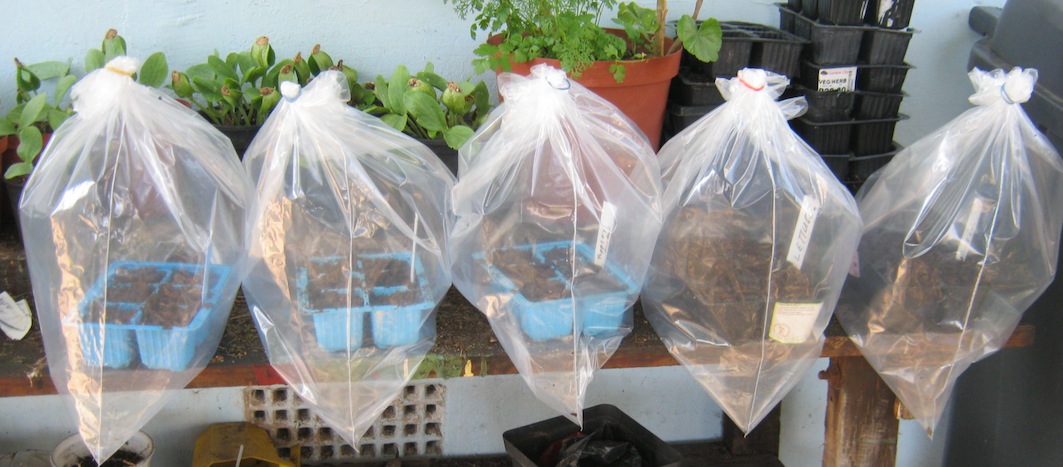
Accessible to anyone, and possibly the cheapest and most water wise way of getting 100% humidity needed for germinating seeds
Growing organic tomatoes from seed
When you sow your seeds, the seedlings with their first two seed leaves should come up after a week, they should have 5 small branched leaves after a month, and bear their first fruits just before two months, if you have planted them out.
Bed preparation
Sources recommend tilling to 1 foot or 30 cm two weeks before planting. This is probably to bury pathogens, otherwise tillage has mainly negative effects. I do not bother to till the soil only to top dress, and get bumper harvests. Crop rotation would be more efficient than tilling, I think. Growing organic tomatoes does not have to break your back.
Choosing the spot
In dark, wet northern regions, tomatoes need at least 6 hours of full sun and well drained soil. Where we live in hot summer drought with strong sunlight, some light afternoon shade helps stabilize their environment. They also can grow in water without soil, as long as there is nitrogen supply (ours comes from fishtanks). Unlike plants in the ground, the plants growing in water thrived in daylong full sun, and the plants got bigger and made suckers, growing vegetatively, and yielding over a kilogram of cocktail tomato fruit from one vine, something I’ve never seen in the ground here. Where the tank got afternoon shade from a small tree, they were puny by comparison.
irrigation and blight
Tomatoes do suffer from blights which are affected by irrigation regimes, when growing organic tomatoes we need to keep it in mind. I’ve written on how to irrigate to avoid this.
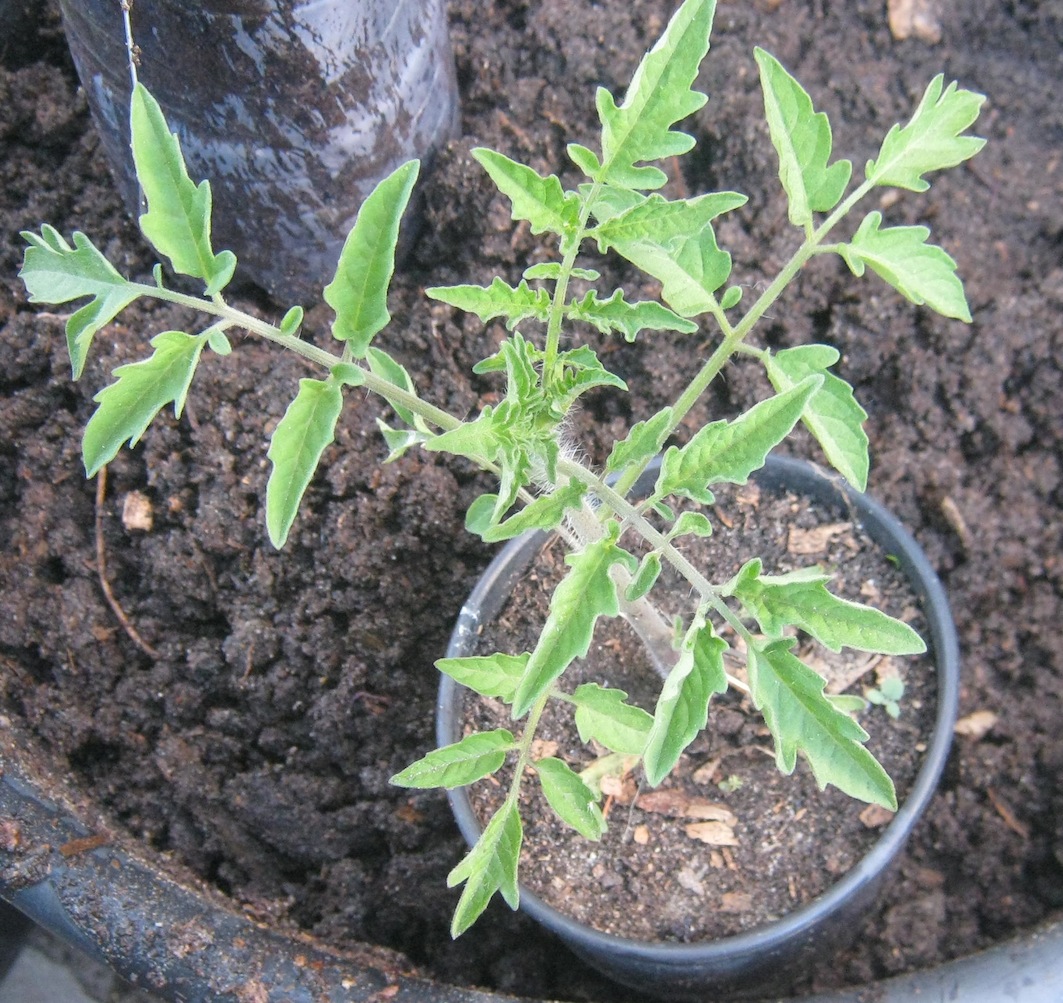
a tomato seedling perfect for planting out
planting out
If you have cold winters you can sow early six to eight weeks before the last spring frost. Harden these plants off for a week before planting out of doors. You can do this by gently exposing them to outdoor conditions over a one week period. On the first day put them outdoors in a wind protected shady area for just two hours, and raise exposure daily until you can leave them out overnight. Also gently increase exposure to direct sunlight.
The recommended spacing is two feet or 60 cm. I think this is a bit generous. However the closer they are the more you have to watch for disease.
It is also recommended to bury the plant deep when transplanting, to a level above the lowest leaves, after pinching them off. This increases secondary rooting around the plant. It is also good to pinch out any low leaves that can contact or get splash back from the ground to prevent blight. If you have a large fish pond (over a cubic metre at least), just pop the tomato seedlings into the filter material in the biofilter, one or two plants per cubic meter of filter should do fine.
Supply supports for the vines planted in the ground, such as stakes, or cages at the time you transplant.
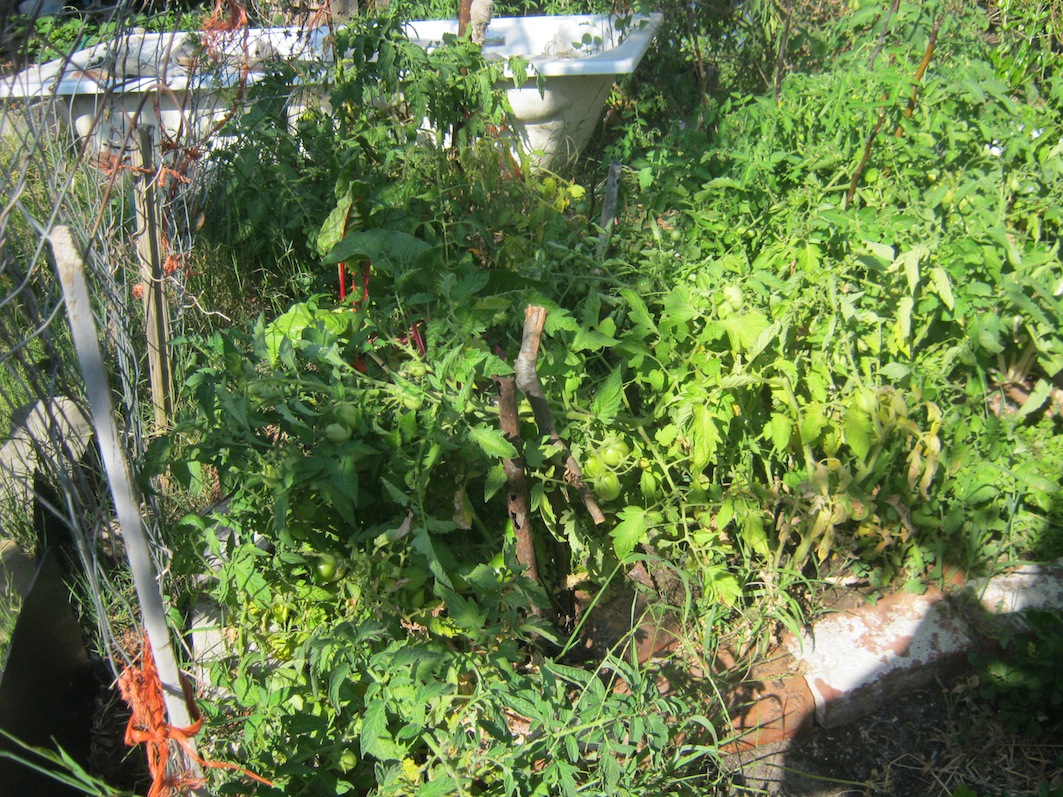
This is how tomatoes look without proper training. It can work, but the lack of air circulation and shading out can introduce blight and reduce the harvest
maintenance
To care for your plants in the ground or in plant pots you should water well immediately after transplanting and for the first few days, then throughout the growing season, and water consistently. Tomatoes do not respond well to environmental shock. Mulch at five weeks just before the first fruit appear. Place large flat rocks next to the plants to conserve water in the ground during dry spells. Fertilize two weeks prior to harvest. An ideal organic alternative would be worm tea.
Tomatoes lying on the ground in their natural state develop multiple stems, so pruning attempts to get them up high and thinned out. Side suckers develop from the axial buds of leaves on the main stem and much of tomato pruning is to remove these so that the main stem is not weakened by competition, and so that the plant does not become too bushy and shaded and disease prone. This applies especially in damp climates. In dry zones, like ours, allowing plants to sprawl on the ground can work if you have lots of space and rotate with non Solanaceous crops. We didn't rotate for 2 years and the blight struck with a vengeance.
So pinch off the suckers growing in the leaf axils every week, leaving only a couple of stems, as desired, and leaving the fruiting stems in place. If multiple stems are desired they should be selected to grow into stems of equal strength.
If you plant in a biofilter that is raised, just let the tomatoes tumble over the side, and across the filter.
Harvest
Tomatoes can be harvested all year round, weather permitting, though the late summer to early autumn harvest tastes the best in areas of the US having less sun in winter. In Cape Town we also plant in summer as our winters are very wet and can have cold spells with snow on the mountains across the Cape Flats. Leave your tomatoes on the vine rather than ripening post harvest. Pick when bright red and still firm and only slightly soft. If they fall pop them in a paper bag and store where its dark and cool. If the winter comes before they ripen, pluck out the whole bush and hang it indoors in cool dry place, and harvest the fruit as they ripen on the vine.
collecting seed for growing organic tomatoes
Collecting your own seed is vital when growing organic tomatoes. Seeds must be harvested from mature, even overripe fruit, and then fermented till clean and dried. Scoop the seed pulp out of a soft fruit, and place in a glass with about twenty times the amount of water. Weather permitting, fermentation will start and the fruit flesh will drop off the seeds, leaving them nice and clean. They can then be washed and dried in a cool, dark, dry place. There are then various permacultural and organically aligned storage options as taught by Karen Parkin who also sells Heirloom seed suited to local conditions.
In store selection
Informative websites tell us to choose food tomatoes whichever colour, that smell sweet with perfect shape and unblemished skin. Criteria focussing on appearance have however impacted negatively on the taste of the fruit over generations. Nonetheless their advice to avoid those which look puffy or have been refrigerated is sound, as they may be insipid. Chilling impacts on these originally tropical fruit negatively, reducing nutrient levels and flavour.
Tomatoes should be allowed to ripen on the vine but this is not possible with commercial shipping so they have been bred to ripen post harvest. They ripen well in a paper bag with other ripening fruit, and once red a little sun intensifies their colour and taste. Those growing organic tomatoes do not have to do this, they can harvest tomatoes bursting with ripeness straight off the vine, the best way. Home garden cultivars also bear for longer periods, staggering the harvest.
------
home page for useful links on waterwise and natural gardening
------
vegetable gardening page with links to all the information on growing veggies
------
tomato blight and how to zap it without doing harm
------
for growing organic tomatoes at home, an exclusive source of Heirloom seed in South Africa
Restore Nature Newsletter
I've been writing for four years now and I would love to hear from you
Please let me know if you have any questions, comments or stories to share on gardening, permaculture, regenerative agriculture, food forests, natural gardening, do nothing gardening, observations about pests and diseases, foraging, dealing with and using weeds constructively, composting and going offgrid.
SEARCH
Order the Kindle E-book for the SPECIAL PRICE of only
Prices valid till 30.09.2023
Recent Articles
-
Geography Research Task
Jan 31, 25 11:37 PM
To whom it may concern My name is Tanyaradzwa Madziwa and I am a matric student at Springfield Convent School. As part of our geography syllabus for this -
Eco Long Drop Pit Latrines Uganda
Nov 29, 24 02:45 AM
Good evening from the UK. My name is Murray Kirkham and I am the chairman of the International and foundation committee of my local Lindum Lincoln Rotary -
Landscape Architect
Oct 01, 24 10:42 AM
I so appreciate your informative description! Your experimentation and curiosity with the seeds, germination, and rearing of the maggot are exciting to
"How to start a profitable worm business on a shoestring budget
Order a printed copy from "Amazon" at the SPECIAL PRICE of only
or a digital version from the "Kindle" store at the SPECIAL PRICE of only
Prices valid till 30.09.2023
